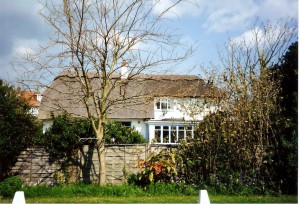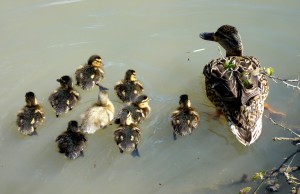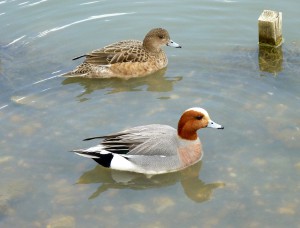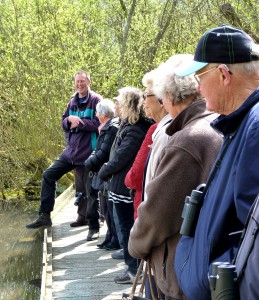As of today (26 August) there are well over 160 objections to this application on the Arun DC website. This illustrates just how unpopular it is, but you still have time to lodge your objection if you wish to do so. You have until the closing date for comments on Thurs 3 September. If you’re thinking about doing so, then please do it for the sake of the village of Ferring. We would like to see well over 200 objections in total. This would give a very clear message to the planners from local people. Details of how to submit your comment are in the post below. Stop Press: Ferring Parish Council also voted overwhelmingly last night to submit a formal objection, as have East Preston Parish Council.
Apartment block to replace thatched cottage in Ferring?
Ferring residents have been stunned by the news that a developer has applied to replace an attractive thatched cottage in a key location with an apartment block. The cottage has been a landmark feature in south Ferring for three generations
‘There will be very strong resistance to this application’, said David Bettiss, Chairman of Ferring Conservation Group. ‘We have 900 members and we shall be encouraging every one of them to send in objections to Arun District Council. It is an outrage – we knew there was a plan already for four chalet bungalows and we  were having to get used to that idea but ten apartments, in a block that covers the whole site, is really gross overdevelopment and shows no regard for the character of Ferring. This area was built in the 1920s and 1930s in a low density arrangement of bungalows and small houses on large plots. A modern apartment block would be completely out of place’.
were having to get used to that idea but ten apartments, in a block that covers the whole site, is really gross overdevelopment and shows no regard for the character of Ferring. This area was built in the 1920s and 1930s in a low density arrangement of bungalows and small houses on large plots. A modern apartment block would be completely out of place’.
‘Not only that but adding ten lots of car owners would increase the traffic congestion and road safety hazards in a narrow road, at a junction on a blind bend, where it is already difficult to turn safely. We would hope the County Council would condemn it on road safety grounds and that Arun district Council will refuse it as overdevelopment, totally out of character for this area.’
Ed Miller, Secretary of Ferring History Group, added, ‘The cottage is not quite as old as some people think but it was one of the first houses built in the development of the 1920s. Its shape and thatched roof earned it the nickname of ‘The Beehive’ and Beehive Lane – the road connecting the inter-war estate to Sea Lane, was named after it in 1928. The house is a dominant feature in one of the earliest photographs of South Ferring, and has been the centrepiece of many postcards. It’s bad enough that we should lose the cottage but to have it replaced by an apartment block is really too much. Our members will certainly fight this application’.
If you agree that this is an unwelcome and unwanted development in the village, you can object to Arun District Council. Their website is www.arun.gov.uk and the reference number of the application by Globe Estates is FG/116/15 – you can view the plans there. Put in your own words why you don’t want this addition to the landscape of Ferring in the comments section of the application.
Big Butterfly Count and Wildflower Walk
Over 20 members of Ferring Conservation Group met up this week on the Ferring Rife to make their contribution to the national Big Butterfly Count organised by the Butterfly Conservation organisation. This was combined with a Summer flower challenge to see how many different plants could be seen.
Members split up into a number of smaller groups to check out areas protected from the strong westerly breeze on what was otherwise a bright and sunny day. The area of both the south and north lagoons on the East Preston side of the river were surveyed, and a total of 10 different species of butterflies were recorded, with 42 individuals around the south lagoon and 36 in the north. Amongst those seen were Gatekeeper, Meadow Brown, Common Blue, Holly Blue, Speckled Wood, Small White and Red Admiral. The results were duly forwarded to Butterfly Conservation to add to the 25,000 submissions so far, and build up a national picture of butterfly distribution.
The Group then moved on to attempt to find at least 12 summer wild flowers in the area as challenged by walk leader and committee member, Tricia Hall. A number of these plants such as Common Fleabane were proving attractive to butterflies and other insects. Amongst the other plants were the white flowered and pleasant smelling Meadowsweet, Hogweed (not the giant version!), Birds’ Foot Trefoil, Knapweed, Yellow Loosestrife, Bristly Ox Tongue and Yarrow. All of these plants together provide an attractive scene, as well as a valuable habitat for our wildlife in this Site of Nature Conservation Interest (SNCI). Most people managed to complete the challenge and find at least 12 different plants, learning about them in the process.
Just to add to the interest, members also found a Bush Cricket, various Ladybirds, some Day Flying Moths and even a small frog discovered by the grandson of one of the Group members, which was released after a quick photograph.
Group Meeting – 31st July 2015
Stuart Card a Conservationist and Qualified Bird Ringer from Warnham Local Nature Reserve (Warnham LNR) opened our July meeting with a fascinating and informative talk about the ‘Captive Breeding and Re-introduction Programme of Harvest Mice’ at Chesworth Farm, Horsham. To our delight and to give our members the perfect photo opportunity Stuart brought along a breeding tank complete with several beautiful harvest mice.
Harvest Mice are Britain’s smallest mammal and weigh between 4 to 6 grams and are only between 50 to 70 mm long. They are the only British mammal to have a prehensile tail which enables them to be incredibly acrobatic. Harvest Mice have many predators including stoats, mink, weasels, foxes, sparrow hawks, barn owls, crows, pheasants and domestic cats.
This breeding programme was established in 2008 when it was realised that Harvest Mice were at risk due to modern farming methods, alterations in sowing practices, pesticides failing to control invasive grasses and climate change creating wet seasons. Harvest Mice cannot warm themselves once their coats are damp. Supported by Friends of Warnham LNR and Horsham DC the programme runs across 4 sites and involves 3 different Public Organisations and 1 private collector.
Harvest mice can breed before they are 1 year old and can produce 3 to 7 litters a year. Their mating season is between May and October. The gestation period is 19 days and litters can range from 1 to 8 young.
Breeding tanks are set up using sawdust, meadow hay, millet sprays for climbing and Finch Wicker baskets to offer additional nesting sites to help emulate a natural environment. Wild bird seed mix and fruit pieces are provided as food sources.
The breeding procedure always starts with 2 males and 2 females in one tank; the dominant female will conceive first. When this occurs the subordinate female is immediately removed. As soon as the subordinate male is identified he must also be removed. The successful breeding pair can be kept together for up to 7 litters. If they have any more than this, the female may die giving birth.
After a break for tea Tricia Hall updated us on the walk on Highdown Hill that took place on 2nd July. Among other species the Yellow Rattle flower was in evidence. This annual plant thrives in grasslands and as its name suggests if you brushed past it in the height of summer you will hear the tiny seeds rattle in their pods. Some excellent photos were taken of the Marble White butterflies as they were nectaring. Tricia brought to our attention that the vegetation had been cut back along the banks of the River Rife leaving only about 10 per cent for wildlife activity.
Ed Miller updated our members with the news that the HM Planning Inspector had asked for the Arun DC Local Plan to be revised to include an extra 180 houses to be built per year over the next 15 years. If an acceptable proposal is not forthcoming then the Local Plan will be rejected and Arun DC will have to start again from scratch. This will leave the door open for developers to pursue planning applications on other sites in the area.
Ed then concluded by announcing that our Group Secretary, Carol Dyball, was stepping down from committee duties after 15 years to concentrate on her move away from Ferring. Ed thanked Carol for all her hard work over the years and wished her the very best in her forthcoming move.
July meeting – change of speaker
For our next members meeting on Friday July 31st (7.30pm back at Ferring Village Hall), we will now be having a visit from Stuart Card, who is a warden at Warnham Local Nature Reserve. He will be giving us a talk on – An Introduction to the Captive Breeding Programme of Harvest Mice at Warnham LNR/ Chesworth Farm (both near Horsham). He will be bringing some of the Harvest Mice with him for you to meet, and there will be an opportunity for you to get some up close photographs, so bring your cameras!
Chris Tomlinson from E.ON will now be coming to our September meeting for an update on the Rampion Wind Farm – this will be in addition to our advertised speaker, who is Dr Dawn Scott (of BBC Springwatch fame) who will be talking on the Brighton Urban Fox Project.
In between these meetings, we have the Summer Social on Saturday August 22nd at 6.30pm again at Ferring Village Hall. Tickets are currently on sale at £10 each – to include a choice of hot main courses, a choice of desserts and a complimentary glass of wine or fruit juice. Tickets can be obtained from Carol Dyball on 249337, or at the July meeting, but be warned – they’re selling fast!
Summer Social tickets now on sale
Summer Social tickets now on sale
Takes place at 6.30pm Saturday 22 August at the Village Hall
Priced at £10 each – to include a choice of hot main course and choice of dessert, plus free glass of wine or fruit juice
An enjoyable evening of good food, good company, good conversation and good entertainment
Get in quick, as tickets always sell out!
Buy them at July 31st members meeting, or contact Carol Dyball on 249337 to book your tickets
Group Meeting – 26th June 2015
For this month only, Ferring Conservation Group held their June meeting at the pleasant St Andrews Church Centre in the village, and were treated to an excellent informative illustrated talk by Jacob Everitt on the topical subject for Ferring of Coastal and Estuarine Birds.
Jacob is the Head Warden at the Warnham Local Nature Reserve near Horsham, and as well being a very effective communicator, he is a very talented photographer and in his spare time is also a bird ringer for the British Trust for Ornithology.
He took us through a journey of many of the birds that we are likely to see on the Sussex coast, as well as our nearby estuaries. He also highlighted the best places to see these birds in the county, but did include the special RSPB reserve of Snettisham in Norfolk, where it is possible to witness the amazing sight of up to 50,000 knot flying close overhead when a high tide forces them on to the reserve lagoons.
Back in Sussex, he described some of the more interesting birds to be seen, such as Kittiwakes, Fulmars, Brent Geese, and Purple Sandpipers, and also why they spend at least some of their lives here. One of the more interesting facts for the wading birds was that each square metre of estuarine mud contains up to 200,000 Kcal – the equivalent of some 77 Mars bars!
Finally, he recommended the best sites to visit to see the birds in their natural environments, and these from east to west were – Rye Harbour, Cuckmere Haven, Seaford Head, and Pagham Harbour, not forgetting the coast off Ferring and the nearby Rife, where we do see a decent selection of these birds on our door step.
In the second half of the meeting, amongst other features, Tricia Hall in her regular Nature Notes, updated members with photographs on the wonderful sight of many Early Marsh Orchids in the Rife lagoon areas, as well as a crop of Flax now flowering on the East Preston Gap, giving it a light blue hue.
June Meeting – change of speaker
We are sorry to let you know that there will be a change of speaker at our meeting on Friday June 26th at 7.30pm (for this meeting only at St Andrews Church Hall). The speaker on Thatching has unfortunately cancelled his booking, but we have been able to bring forward the July speaker to this month.
Our June speaker is now Jacob Everitt (the warden at Warnham Nature Reserve) who will give an illustrated talk on Coastal and Estuarine Birds – very appropriate for our location and to help you identify all those wading birds. He has a lot of knowledge and is an excellent photographer, so it should be an entertaining evening.
The July meeting will now hear from Chris Tomlinson from E.ON who will give us an update on the latest plans for the Rampion Wind Farm, and there will be an opportunity to ask him questions. This meeting will be back at Ferring Village Hall – 7.30pm Friday July 31st.
Group Meeting – 22nd May 2015
Tom Simpson from the Sussex Wildlife Trust found himself among sympathetic and like-minded people when he gave an interesting and informative presentation to Ferring Conservation Group at their May meeting on the ‘Wild about Worthing’ project. This new project aims to reconnect people with nature and to encourage the joining up of habitats to help wildlife flourish and create a Living Landscape.
The project is supported by a grant from the Lottery Fund and promotes identifying and recording wildlife that lives around Worthing. Surveys will be launched over the next 2 years and focus on 7 target species ranging from bumblebees, butterflies and stag beetles to slow worms, swifts, hedgehogs and the ‘mermaid’s purse’ egg cases of the skates, rays and cat sharks. The findings can be recorded online and will link in with the Sussex Biodiversity Record Centre.
There are many environmental educational wildlife events that aim to encourage young people to enjoy being outdoors and to be inspired by nature. Whereas people of all ages can join in with ‘wildlife gardening projects’ and also learn to appreciate that our streets, parks and school grounds can offer habitats for a whole range of species.
After a break for tea Tricia Hall delivered her welcome Nature Notes and informed us that a colourful hoopoe bird had been spotted in a garden in Midhurst Close. She then showed us a photograph of a pretty whitethroat sitting in a tree near the river Rife, one of several that had been spotted in the same area. Only a few butterflies had been seen due to the cold weather in May but wildflowers such as buttercups in Sea Lane and cow parsley and the yellow flag iris on the banks of the river Rife were particularly attractive this year. Tricia then thanked the Group for their donation of a willow tree in memory of her husband, Mike Hall, which was planted in a field adjacent to her house.
Ed Miller commenced his planning update with the welcome news that no planning applications for housing had been received recently by Arun DC. Foschini Nursery have organised 2 Open Days on 29th and 30th May for the public to view their proposal for 6 mobile homes plus farm shop and café, including the conversion of an agricultural shed to accommodate the manager of the new complex. Ed also advised our Group that the legal process for the banning of overnight parking along the seafront had commenced.
Michael Brown then gave us news that permission had been granted for the onshore work for the Rampion Windfarm would begin in 2015 and the offshore work in 2016. Chris Tomlinson, Eon’s project manager, has been invited to talk to our Group at our July meeting.
Our chairman David Bettiss concluded the meeting with dates of 2 forthcoming nature walks. Shingle beach walk at Shoreham to identify plants and fauna on Monday 22nd June meet at 2pm at Shoreham Fort car park. Highdown Hill to identify butterflies meet at 2pm in car park on Thursday 2nd July.
Group Visit to Wildfowl and Wetlands Trust at Arundel
On a sunny but cold and windy day around 25 members of Ferring Conservation Group enjoyed a visit to Arundel Wetlands Centre. Originally built on an old watercress farm the Centre covers 65 acres and is nestled in the scenic South Downs with views of Arundel Castle. With steep woodlands stretching along its rear boundary and with the River Arun and a historic water mill stream alongside its borders, it is truly a stunning location.
The Arundel Centre supports a rich array of British Wildlife as well as a large collection of international wildfowl. This is due to the centre benefitting from a pure water supply that is naturally filtered by the layers of chalk which are part of the South Downs landscape.
Visiting and resident British species include many small birds, such as reed and sedge warblers, 11 species of bat, cuckoos, dragonflies, grass snakes, swans, bee orchids to name a few.
A safari boat ride can be taken through the reed beds to hopefully glimpse a kingfisher or water vole.
Our Group was fortunate to be guided around the Centre by Paul Stevens, the reserve manager. Paul began by explaining that the reed beds held a Site of Special Scientific Interest (SSSI) status but our chances of spotting a water vole for instance on that particular day were slim because of their dislike of wind.
On our arrival at the Lapwing hide we were rewarded by the sight of an adult bird with 2 chicks around 5 to 6 days old foraging for food on the island. As we left the hide we spotted a Buzzard circling above and in another direction were House Martins gliding and flitting who are welcome summer visitors. Our tour then progressed along the board walk over the reed bed and here we stopped to listen to Reed, Sedge and Cettis Warblers.
The many ducks and geese waddling around keeping a very watchful eye on their young also enhanced our enjoyment of the day. So with our thanks to Paul for a very interesting and informative tour our members made their way back to the Water’s Edge Café overlooking the Arun Riverlife Lake for some welcome refreshment.




